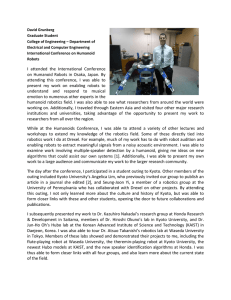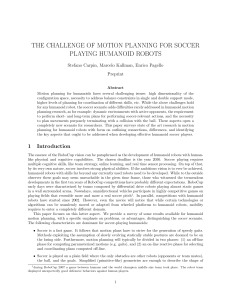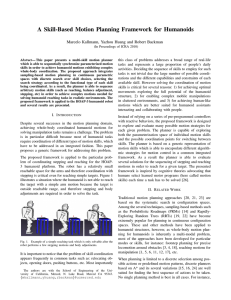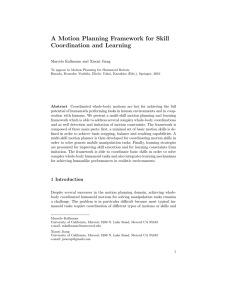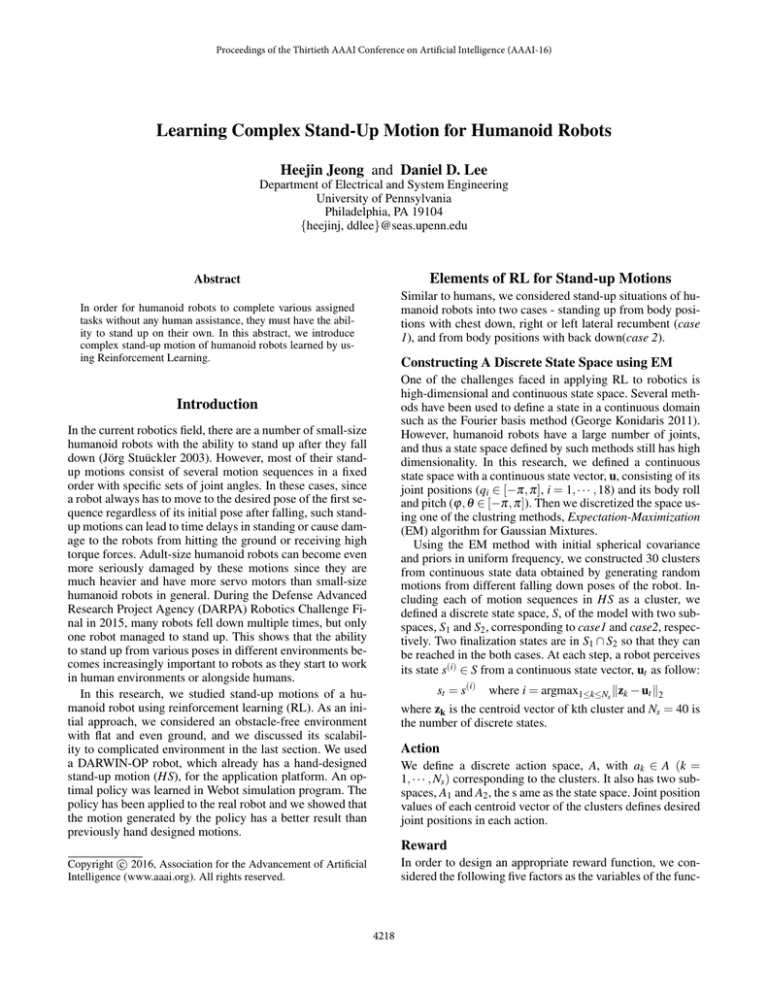
Proceedings of the Thirtieth AAAI Conference on Artificial Intelligence (AAAI-16)
Learning Complex Stand-Up Motion for Humanoid Robots
Heejin Jeong and Daniel D. Lee
Department of Electrical and System Engineering
University of Pennsylvania
Philadelphia, PA 19104
{heejinj, ddlee}@seas.upenn.edu
Elements of RL for Stand-up Motions
Abstract
Similar to humans, we considered stand-up situations of humanoid robots into two cases - standing up from body positions with chest down, right or left lateral recumbent (case
1), and from body positions with back down(case 2).
In order for humanoid robots to complete various assigned
tasks without any human assistance, they must have the ability to stand up on their own. In this abstract, we introduce
complex stand-up motion of humanoid robots learned by using Reinforcement Learning.
Constructing A Discrete State Space using EM
One of the challenges faced in applying RL to robotics is
high-dimensional and continuous state space. Several methods have been used to define a state in a continuous domain
such as the Fourier basis method (George Konidaris 2011).
However, humanoid robots have a large number of joints,
and thus a state space defined by such methods still has high
dimensionality. In this research, we defined a continuous
state space with a continuous state vector, u, consisting of its
joint positions (qi ∈ [−π, π], i = 1, · · · , 18) and its body roll
and pitch (ϕ, θ ∈ [−π, π]). Then we discretized the space using one of the clustring methods, Expectation-Maximization
(EM) algorithm for Gaussian Mixtures.
Using the EM method with initial spherical covariance
and priors in uniform frequency, we constructed 30 clusters
from continuous state data obtained by generating random
motions from different falling down poses of the robot. Including each of motion sequences in HS as a cluster, we
defined a discrete state space, S, of the model with two subspaces, S1 and S2 , corresponding to case1 and case2, respectively. Two finalization states are in S1 ∩ S2 so that they can
be reached in the both cases. At each step, a robot perceives
its state s(i) ∈ S from a continuous state vector, ut as follow:
Introduction
In the current robotics field, there are a number of small-size
humanoid robots with the ability to stand up after they fall
down (Jörg Stuückler 2003). However, most of their standup motions consist of several motion sequences in a fixed
order with specific sets of joint angles. In these cases, since
a robot always has to move to the desired pose of the first sequence regardless of its initial pose after falling, such standup motions can lead to time delays in standing or cause damage to the robots from hitting the ground or receiving high
torque forces. Adult-size humanoid robots can become even
more seriously damaged by these motions since they are
much heavier and have more servo motors than small-size
humanoid robots in general. During the Defense Advanced
Research Project Agency (DARPA) Robotics Challenge Final in 2015, many robots fell down multiple times, but only
one robot managed to stand up. This shows that the ability
to stand up from various poses in different environments becomes increasingly important to robots as they start to work
in human environments or alongside humans.
In this research, we studied stand-up motions of a humanoid robot using reinforcement learning (RL). As an initial approach, we considered an obstacle-free environment
with flat and even ground, and we discussed its scalability to complicated environment in the last section. We used
a DARWIN-OP robot, which already has a hand-designed
stand-up motion (HS), for the application platform. An optimal policy was learned in Webot simulation program. The
policy has been applied to the real robot and we showed that
the motion generated by the policy has a better result than
previously hand designed motions.
st = s(i)
where i = argmax1≤k≤Ns zk − ut 2
where zk is the centroid vector of kth cluster and Ns = 40 is
the number of discrete states.
Action
We define a discrete action space, A, with ak ∈ A (k =
1, · · · , Ns ) corresponding to the clusters. It also has two subspaces, A1 and A2 , the s ame as the state space. Joint position
values of each centroid vector of the clusters defines desired
joint positions in each action.
Reward
c 2016, Association for the Advancement of Artificial
Copyright Intelligence (www.aaai.org). All rights reserved.
In order to design an appropriate reward function, we considered the following five factors as the variables of the func-
4218
(a)
(b)
(c)
Figure 1: (a) Final Q values; (b) State-Action Planning Map (red: case1, blue: case2, green: finalization); (c) Comparison
between the stand-up motion learned by RL and the previously hand-designed motions(HS)
plays a key role in reducing unnecessary exploring time and
preventing a robot from being damaged. Therefore, we restricted the exploration area of a state s ∈ Sl as Al (table
1) and assigned different initial Q(s ∈ Si , a ∈ A j ) to the different cases: 0.01 for i = j, −0.1 for i = j, and 0.1 for
i = j = 1 ∩ 2. The numerical values were determined according to the range of reward values and the learning rate:
αt = α(st , at , ut ) = cp(s|ut )/(1 + visits(st , at ))
where c is a scaling constant and p(s|u) is the probability
density function of having the current discrete state given
the current continuous state under the Gaussian distribution,
p(sk |ut ) = (2πσ 2 )−1/2 exp(− ut − zk 22 /(2σ 2 )). This can
be considered as a weight of the learning rate.
tion (at time step, t): Cumulated difference of body angular
acceleration, Difference of current body attitude from desired attitude, Body height change (Ht − Ht−1 ), Body pitch
change (pt − pt−1 ), and Body roll change (rt − rt−1 ). Then
the hyperbolic tangent function is used for each variable, xi ,
with different constant parameters (wi , ci , νi and bi ) to saturate at larges values and to exponentially increase or decrease at other values (Line 19 in table 1). The parameters
were determined by considering trade-off among the effects
of the variables.
Learning Algorithm
Q-learning is used (γ = 0.9) for the learning method. In
RL, especially in a robotics system with relatively high dimensional state and action space, an exploration strategy
Result and Evaluation
Applying the RL model and the learning algorithm (table 1)
in the simulation, we obtained the final Q values (Figure 1a)
and the optimal policy. The figure 1b shows the map of the
policy. The stand-up motion using the policy was compared
with HS in cases of eight different initial falling down poses
including the prone position (case 7) and the supine position
(case8). The upper plot in the figure 1c shows the number
of transitions and the lower plot shows its stability in each
motion. We can see that the new stand-up motion is more
stable in all cases except the case 8 with a little difference.
In addition, the number of transitions of the new stand-up
motion is less than or equal to the HS motion except the case
6 when a more stable set of motion sequences is required.
This approach can be expanded to more complicated environments such as inclined planes, uneven ground, or environments with obstacles by applying more advanced methods in RL.
Algorithm
At step t,
Input: st = s, s ∈ Sl
Qmax = maxa ∈A Q(s, a ) valid for only unique maximum value.
1. if a solution has not yet found then
2. Qave,s = (∑a ∈Al Q(s, a ))/n
3. if visits(s, a) > 0 for all a ∈ Al or Qmax > Qave + Qδ ,2
4.
if Qmax > (Qave + Qδ ,1 )or ∑ visits(s, ·) > 3|Al | then
5.
at = argmaxa ∈A Q(s, a )
6.
if visits(st , at ) > 4 then
7.
π(s) = at
8.
end if
9.
else
10.
at = random(a, a ∈ Al )
11.
end if
12. else
13.
at = a where visits(s, a) = 0, a ∈ Al
14. end if
15. else
16. at = π(s)
17. end if
18. Action Execution
19. Getting Rewards: rt = ∑5i=1 wi (tanh ci (xi,t − νi ) + bi )
20. Q-update:
Q(st , at ) ← Q(st , at ) + αt rt + γ · maxa Q(st+1 , a ) − Q(st , at )
References
George Konidaris, Sarah Osentoski, P. T. 2011. Value Function Approximation in Reinforcement Learning using the
Fourier Basis. Association for the Advancement of Artificial
Intelligence.
Jörg Stuückler, Johannes Schwenk, S. B. 2003. Getting
Back on Two Feet: Reliable Standing-up Routines for a Humanoid Robot. IOS Press.
Table 1: Learning Algorithm
4219


